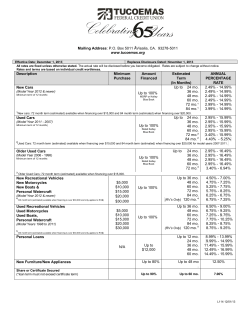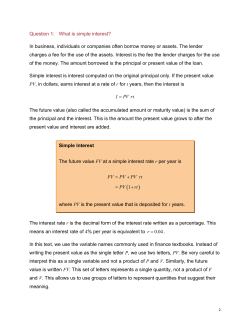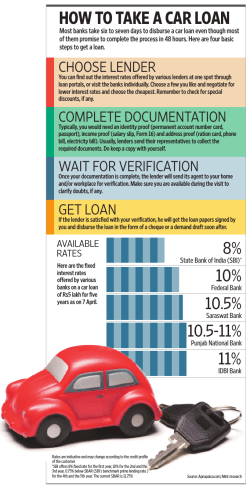
CMBS 2.0: What is it?
CMBS 2.0: What is it? Presentation to Practising Law Institute’s Commercial Real Estate Financing 2012: Getting Back to Business February 13, 2012 Kahlil T. Yearwood Dechert LLP +1 415 262 4522 [email protected] © 2012 Dechert LLP Presentation Overview 2 • Introduction • Deal Comparison 1.0 v 2.0 • CMBS 2.0 – How are the securitization structures different? • CMBS 2.0 – How are the loan terms different? Introduction • The CMBS Market – Past and Present – There was over $230 billion of CMBS issuance in 2007. – Issuance was dramatically lower in 2008 and 2009 with traditional conduit/fusion pool numbers even lower as many of the CMBS offerings in those years were resecuritizations or single asset securitizations. – CMBS 2.0 refers to the resurgent capital markets commercial real estate loan origination and securitization industry which restarted in 2010. – Mid-2011 issuance topped $20 billion with many expecting $40 billion by year end; however, global economic concerns limited issuance to about $30 billion for the year. – 2012 issuance is currently projected to be comparable to 2011 levels. 3 Introduction • CMBS 2.0 – what does it mean? – Deals of a certain vintage? e.g. 2010 – present deals? Maybe, but there is significant variation during that period. – Changes to securitization legal structures at the bond level? – Changes to securitization subordination levels and other business terms? – Changes to loan structures (legal) at the borrower level? – Changes to loan structures (business underwriting) at the borrower level? 4 • CMBS 2.0 as a euphemism for “lessons learned”. • Important Note: each deal is different – the concepts described in this presentation will be present in some deals and not in others and where they exist may be implemented differently from deal to deal. Deal Comparison – 1.0 v 2.0 5 CMBS 1.0 Bond Structure Class Amount ($) Rating Credit Support (%) Public Securities A-1 $75,000,000 Aaa ~30% A-2 $725,300,000 Aaa ~30% A-3 $246,609,000 Aaa ~30% A-AB $72,00,000 Aaa ~30% A-4 $3,661,032,000 Aaa ~30% A-1A $514,000,000 Aaa ~30% A-M $80,000,000 Aaa ~20% A-J $756,277,000 Aaa ~13% B $519,941,000 Aa1 ~12% C $75,628,000 Aa2 ~11% D $94,535,000 Aa3 ~10% E $56,720,000 A1 ~9% F $56,721,000 A2 ~8% Private Securities X $7,562,773,702 Aaa N/A G $75,628,000 A3 ~7% H $103,988,000 Baa1 ~6% J $94,534,000 Baa2 ~5% K $75,628,000 Baa3 ~4% L $37,814,000 Ba1 ~3.25% M $18,907,000 Ba2 ~3% N $28,360,000 Ba3 ~2.625% O $18,907,000 B1 ~2.375% P $18,907,000 B2 ~2.125% Q $18,907,000 B3 ~1.875% S $141,802,702 NR N/A *** Based on the pro supp for a 2007 vintage deal (numbers have been modified). 6 Items of note: • 30% credit support for “super senior” bonds • 20% credit support for certain junior AAA bonds and 13% credit support for more junior AAA bonds • A-1 through F publicly registered. • X and G through S privately placed. • 24 bond classes (plus the IO classes) • $7.5 billion total deal size CMBS 2.0 Bond Structure Class Amount ($) Rating Credit Support (%) Public Securities A-1 $60,000,000 Aaa (sf) ~30% A-2 $80,000,000 Aaa (sf) ~30% A-3 $570,000,000 Aaa (sf) ~30% A-AB $90,00,000 Aaa (sf) ~30% Private Securities X-A $900,000,000 Aaa (sf) N/A X-B $245,000,000 Aaa (sf) N/A A-S $120,000,000 Aaa (sf) ~20% B $65,000,000 Aa3 (sf) ~14% C $45,000,000 A3 (sf) ~10% D $50,000,000 Baa3 (sf) ~6% E $20,000,000 Ba2 (sf) ~4% F $10,000,000 B2 (sf) ~3% G $35,000,000 NR N/A *** Based on a pre-sale report for a recent deal (numbers have been modified). 7 Items of note: • 30% credit support for “super senior” bonds • 20% credit support for junior AAA bonds • $800 million (A-1, A-2, A-3, A-AB) publicly registered. • $345 million (remainder) privately placed. • Only 11 bond classes (plus the 2 IO classes) • $1.1 billion total deal size CMBS 1.0 v 2.0 Comparison 8 CMBS 1.0 Example CMBS 2.0 Example – Deal size: $7.5 billion – Deal size: $1.1 billion – 202 fixed rate loans secured by 353 properties – 80 fixed rate loans secured by 120 properties – Average Loan Size: $37.5 million – Average Loan Size: $14.5 million – Weighted average interest rate ~5.821% (range from 5.330% to 7.939%) – Weighted average interest rate ~5.70% (range from 4.390% to 7.250%) – Weighted Average DSCR: 1.31X – Weighted Average DSCR: 1.57X – Weighted Average LTV: 73.6% – Weighted Average LTV: 63.3% CMBS 1.0 v 2.0 Comparison (cont.) 9 CMBS 1.0 Example CMBS 2.0 Example Amortization / Interest Only Amortization / Interest Only – Amortizing: 17 loans (3.4% of the pool) – Amortizing: 74 loans (79.3% of the pool) – Partial IO: 69 loans (16.3% of the pool) – Partial IO: 3 loans (17.8% of the pool) – Full IO: 116 loans (80.3% of the pool) – Full IO: 3 loans (2.9% of the pool) Subordinate Debt Subordinate Debt – B notes: 16 loans (10% of the pool) – B note: 1 loan (0.7% of the pool) – Mezz Debt: 14 loans (8.4% of the pool) – Mezz Debt: none – Permit Future Mezz Debt: 39 loans (23% of the pool) – Permit Future Mezz Debt: none Additional Recent 2.0 Deal Highlights • Cash Management – In-place hard lockbox provisions: 34 loans (61.2% of the pool balance) – Springing hard lockbox provisions: 30 loans (25.3% of the pool balance) – Soft or springing soft lockbox provisions: 8 loans (9.9% of the pool balance) – No cash management: 8 loans (3.5% of the loan balance) • Escrows – Real estate taxes: 84.7% of the pool balance – Insurance: 63.8% of the loan balance – Capital Expenditures: 72.4% of the loan balance – Tenant improvements / leasing commissions: 57.0% (based on office, retail, industrial and mixed use component balance) • Sponsor Bankruptcy – Four loans (6.8% of the pool balance) have a borrower principal/sponsor that has previously filed for bankruptcy 10 CMBS 2.0 – How are the securitization structures different? 11 CMBS 2.0 – Securitization Level • Generally, CMBS 2.0 securitizations are smaller • Generally, CMBS 2.0 securitizations have fewer loans • Generally, CMBS 2.0 securitizations have fewer bond classes Some Drivers: 12 • Market volatility and difficulty hedging during loan aggregation can reduce or eliminate profits • Increased cost of capital incentivizes regular/speedy securitization • Some bond buyers want smaller, simpler deals so that they can underwrite, analyze and price more easily. (Some bond buyers prefer larger deals because of the increased diversity.) CMBS 1.0 – Consent Rights Major Servicing Actions and Special Servicer Replacement 13 • The “controlling class” (or its representative) has the right to consent to certain major servicing actions (subject to a “servicing standard override”) and to replace the Special Servicer. • The “controlling class” is the most subordinate class of certificates which has at least 25% of its initial certificate balance outstanding after application of any realized losses. • In CMBS 1.0, control moves up the capital stack without limits so that control is held by the most subordinate class of certificates that has nominal “skin in the game” even if that class was originally an investment grade class and is held by financial buyers who do not have the capacity or experience to be involved in major servicing decisions. CMBS 2.0 – Consent Rights Major Servicing Actions and Special Servicer Replacement 14 • Subordinate Control Period: If at least 25% of the initial certificate balance of one of the control eligible classes is outstanding after application of any realized losses and appraisal reductions, then the applicable control eligible class has the right to consent to certain major servicing actions and to replace the Special Servicer. • The “control eligible classes” are a specified number of the junior most classes of certificates and in most deals are all initially purchased by the b-piece buyer. CMBS 2.0 – Consent Rights in 2.0 Major Servicing Actions and Special Servicer Replacement 15 • Subordinate Consultation Period: If at least 25% of the initial certificate balance of one of the control eligible classes is outstanding after application of any realized losses (but without regard to appraisal reductions), then the applicable control eligible class has the right to consult with respect to certain major servicing actions, but not approve actions or the right to replace the Special Servicer. • During a Subordinate Consultation Period, the “Senior Trust Advisor” also has consultation rights. • If no control eligible class has at least 25% of its initial certificate balance outstanding after application of realized losses (and without regard to appraisal reductions), then the control eligible classes will have no consent or consultation rights. CMBS 2.0 – Senior Trust Advisor Who is the Senior Trust Advisor? 16 • Also known as the “trust advisor” or the “operating advisor” (not to be confused with the operating advisor appointed by the controlling class or b-note holder in some CMBS 1.0 deals) • Provides certificateholders with an annual assessment of the Special Servicer’s performance on a platform-level basis with respect to the resolution and liquidation of specially serviced loans. Also, reviews calculations of appraisal reduction amounts and Special Servicer calculations of net present value recoveries on proposed defaulted loan resolution activities. CMBS 2.0 – Senior Trust Advisor (cont.) Who is the Senior Trust Advisor? 17 • During a Subordinate Control Period – responsible for basic monitoring but typically no consultation rights over major servicing decisions. • During a Subordinate Consultation Period – joint consultation rights with the controlling class representative. • After a Subordinate Consultation Period – sole right to consult with the Special Servicer and other responsibilities. CMBS 2.0 – Senior Trust Advisor Senior Trust Advisor Compensation / Expenses 18 • Trust Advisor Fee - accrues based on the outstanding principal balance of each mortgage loan and is paid monthly from interest collected on each mortgage loan. • Trust Advisor Consulting Fee – paid in connection with certain major servicing actions where the Senior Trust Advisor engages in consultation, but only if collected from the mortgage borrower. • Trust Advisor Expenses – certain expenses of the Senior Trust Advisor are paid from pool collections (which can lead to shortfalls to the most subordinate classes), although some transactions only allow these expenses to be paid from amounts otherwise payable to the non-control eligible classes. CMBS 2.0 – Replacing the Special Servicer • During a Subordinate Control Period: – Controlling Class Representative of the most subordinate control eligible class can replace the Special Servicer. • During a Subordinate Consultation Period: – Controlling Class Representative no longer has the right to replace the Special Servicer. – The holders of 25% of voting rights of “non-appraised out” classes can request a vote. – The Special Servicer is replaced based on 75% of all “non-appraised out” classes or 50% of each “non-appraised out” class. – The requesting certificateholders must pay expenses and the cost of rating agency confirmation. • After a Subordinate Consultation Period: – The Senior Trust Advisor can also recommend replacement of the Special Servicer. 19 CMBS 2.0 – Replacing the Special Servicer • Intent: – The Special Servicer replacement process was changed, in part, to address perceived abuses by the “first loss” piece, e.g. extending a loan to avoid a realized loss when foreclosure would be in the best interests of the “lender” taken as a whole. • Practical Considerations: – Some senior bond buyers (e.g. certain mutual funds) do not have the practical ability to pay the costs to call for a vote. – A sufficient percentage of certificateholders can be difficult to track down. – The interests of the trust may be better served by an attentive first loss class with actual skin in the game than by investment grade buyers who may not have the desire or ability to monitor specific loans. (This is the view of b-piece buyers and some investment grade bond buyers). – In practice, it may be that the Special Servicer won’t be replaced unless a particularly large bondholder seeks to have them replaced. 20 CMBS 2.0 – Special Servicer Compensation 21 • Modification fees received by the Special Servicer are offset against workout/liquidation fees on the same mortgage loan. • In some deals, workout/liquidation fees are reduced for large loans, e.g. 0.75% for loans over $25 million and 1% for loans $25 million or less. • Some have suggested a prohibition on the hiring of affiliates by the Special Servicer to eliminate perceived abuses. CMBS 2.0 – Waterfall Change 22 • Generally, interest collections plus advances of interest are allocated to pay interest to all certificateholders and principal collections are applied to the most senior outstanding class of certificates until repaid in full. • In CMBS 2.0, on the liquidation of an asset, collections are allocated to unpaid interest only to the extent such interest was eligible to be advanced (i.e. had not been subject to appraisal reductions), then to principal, and finally to interest that was previously not paid due to appraisal reductions. • In CMBS 1.0, on the liquidation of an asset, collection were allocated to interest without regard to appraisal reductions which resulted in the possibility that subordinate classes would receive interest in a circumstance where there was a principal loss on the loan (which would erode the credit support of the more senior classes). CMBS 2.0 – SEC 17(g)(5) SEC Rule 17(g)(5) – information to all rating agencies 23 • Intent: require that sufficient information be provided to “non-hired” rating agencies so that they could provide unsolicited ratings / surveillance. • Requirement: information provided to “hired” rating agencies must be posted to a website available to “non-hired” rating agencies. • Implementation: communication between the servicer and rating agencies is either in writing via the 17(g)(5) website or is summarized and the summary is then posted to the 17(g)(5) website. CMBS 2.0 – Reps 24 • What reps are we talking about? The reps made by loan sellers about loans in the securitization for the benefit of the certificateholders. • Most CMBS programs have their own set of reps, although there is a fair amount of similarity across programs. • SEC Rule 17(g)(7) requires that rating agencies identify deviations from “industry standard” reps (but doesn’t indentify the industry standard reps or provide guidance to the rating agencies regarding how to determine the industry standard reps). CMBS 2.0 – Reps (cont.) 25 • While CMBS loan seller reps are typically quite extensive, some senior bond buyers have pushed for expanded reps. • Robust reps are being considered as a possible (partial) alternative to risk retention. • A CREFC (industry group) committee has created “model” reps, but these have generally not been used by issuers. • Conclusion: it remains to be seen whether issuers will adopt “industry standard” reps. CMBS 2.0 – Regulatory Issues • Dodd-Frank – Risk Retention – 5% risk retention – Expanded reps and warranties – Premium Capture Cash Reserve Account (in the notice of proposed rulemaking, but not Dodd-Frank) – Safe harbor based on underwriting • FDIC True Sale Safe Harbor – The revised FDIC True Sale Safe Harbor requirements are difficult to satisfy. As a practical matter, bank sponsored CMBS transactions no longer have the benefit of the FDIC True Sale Safe Harbor. 26 CMBS 2.0 – How are the loan terms different? 27 How is CMBS 2.0 Loan Sizing Different? 28 • Use of Debt Yield (i.e. net operating income divided by the loan amount) in addition to (or instead of) DSCR • Higher DSCR is generally expected • Net operating income calculation is generally based on actual cash flow (not pro forma rents) • Lower LTV is generally expected • Amortization is generally expected (full or partial IO are no longer commonplace) • There have been fewer loans with b-notes or mezzanine debt How are CMBS 2.0 Loan Documents Different? 29 • “GGP Changes” (Independent Directors) • Recourse Guarantees • Cash Management CMBS 2.0 – “GGP Changes” 30 • Independent directors obtained only from national service providers • Prohibit borrower from replacing independent directors without giving lender prior written notice • Some deals require the borrower’s organizational documents to require independent directors to consider only the interests of the borrower and its creditors prior to approving a bankruptcy filing (i.e. specifically excluding consideration of the corporate enterprise) • No exceptions to the “no comingling” SPE covenant CMBS 2.0 – Recourse Guarantees • “Warm Bodies” > Third Party > Borrower • Ongoing Financial Reporting and Financial Tests are more common, including net worth and liquidity requirements • CMBS 1.0 Guarantees have withstood court challenges – Upheld claim regarding misapplication of settlement proceeds – Rejected argument that a springing recourse guaranty constituted an unenforceable liquidated damages provision – Upheld full liability after a voluntary bankruptcy filing – Upheld full liability after misapplication of rents and failure to maintain SPE status – in some cases court decisions have been contrary to what might be expected in non-recourse lending, e.g. liability for failure to remain solvent. 31 CMBS 2.0 – Cash Management 32 • Lockbox and cash management at origination are more common • Tax and Insurance reserves are more common • Other reserves (e.g. rollover and cap ex reserves) are more common Q&A
© Copyright 2025










